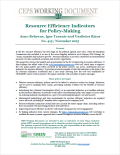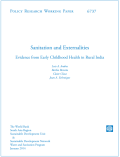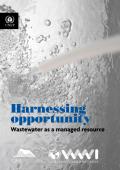
Severe pollution incidents have provided some of the most visually arresting images of recent armed conflicts. Oil fires and spills, bomb-damaged and looted industrial facilities, abandoned military material and munitions, rubble and demolition waste – all are associated with contemporary conflicts, and all can threaten ecosystems and human health. But these obvious, and often serious, sources of pollution rarely tell the whole story. The relationship between armed conflict and pollution – or what we view as the toxic remnants of war – can be complex, and its legacy can last for decades after conflicts end. While it is a problem that has received increasing attention in recent years, too little is currently done to minimize the generation of pollutants in conflict and military activities, and to examine and address their impact on human health and the environment.

In the EU, resource efficiency has been high on the political agenda since 2011, when the European Commission first included it as one of the seven flagship initiatives in its Europe 2020 Strategy for “smart, sustainable and inclusive growth”. Resource efficiency is not only considered an environmental necessity, but also a political, economic and security opportunity.
This paper first stresses the benefits and opportunities for the EU of improving its resource efficiency. It then explains the added value of the www.measuring-progress.eu web tool, which aims to improve the way policy-makers and others involved in the policy process can access, understand and use indicators for resource efficiency. It provides practical examples of relevant indicators in the form of the EU Resource Efficiency Scoreboard and a case study showing how the web tool established by NETGREEN can be used in practice. The paper concludes with a number of policy messages.

In December 2015, the European Commission published the new Circular Economy Package, containing a host of initiatives to reduce waste and to increase the longevity of products and materials, but it failed to set a headline target for reducing the EU’s use of resources. Such a target could help to increase political attention and visibility of the issue, stimulate long-term ambitions and streamline the action of all actors – both public and private – towards reducing the consumption of natural resources.
In order to gain political support for such a target, this CEPS Policy Brief highlights two preconditions that need to be obtained:
- The target needs to be based on an attractive vision for change shared by a majority of stakeholders (including business and industry).
- It needs to be based on robust and consistent indicators across the EU – both on the public and on the company level.
Meeting these two preconditions will considerably ease the introduction of a policy mix aimed at fostering more circular business models.

The paper "Sanitation and Externalities: Evidence from Early Childhood Health in Rural India" estimates two sources of benefits related to sanitation infrastructure access on early childhood health: a direct benefit a household receives when moving from open to fixed-point defecation or from unimproved sanitation to improved sanitation, and an external benefit (externality) produced by the neighborhood’s access to sanitation infrastructure. The paper uses a sample of children under 48 months in rural areas of India from the Third Round of District Level Household Survey 2007– 08 and finds evidence of positive and significant direct benefits and concave positive external effects for both improved sanitation and fixed-point defecation. There is a 47 percent reduction in diarrhea prevalence between children living in a household without access to improved sanitation in a village without coverage of improved sanitation and children living in a household with access to improved sanitation in a village with complete coverage. One-fourth of this benefit is due to the direct benefit leaving the rest to external gains.

Wastewater is a valuable resource that we need to harness. That is the key message in a new publication from UN Environment, the Global Programme of Action and the Global Wastewater Initiative.
The issue of what to do with wastewater, that is water that has been adversely affected by human activities such as farming, industrial production and domestic use, has long challenged development experts, companies, environmentalists, policymakers and urban planners alike. And although improvements have been made, it is still true that globally, about 80 per cent of wastewater is being discharged untreated. This has negative consequences for nature and humans alike. Untreated wastewater degrades the marine environment, and can contribute to the creation of so-called dead zones. Areas of the ocean that are so depleted of oxygen that they are void of marine life. At the same time, poor wastewater management and improper sanitation represent a significant factor in the spread of infectious disease.
